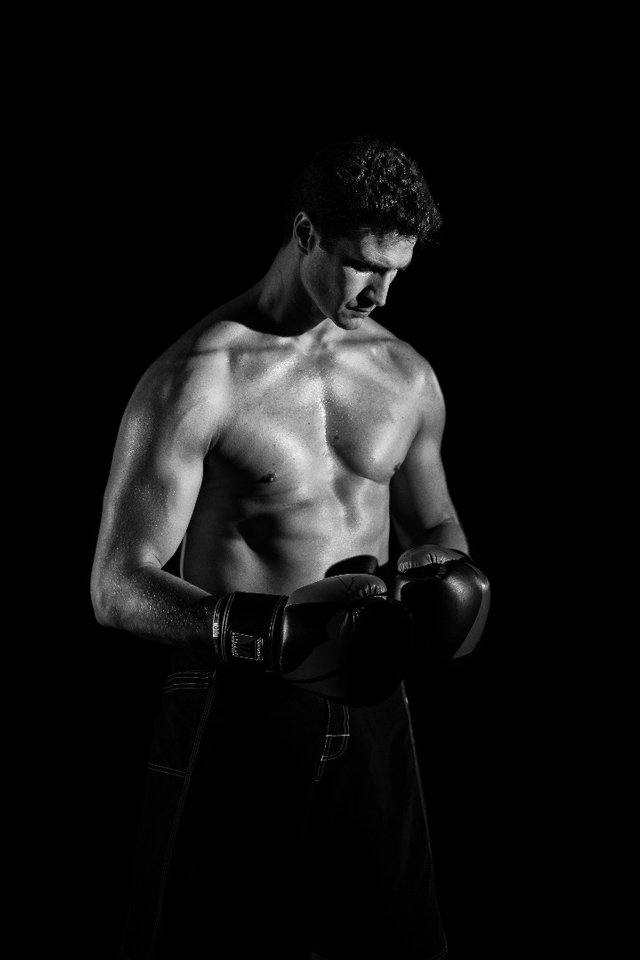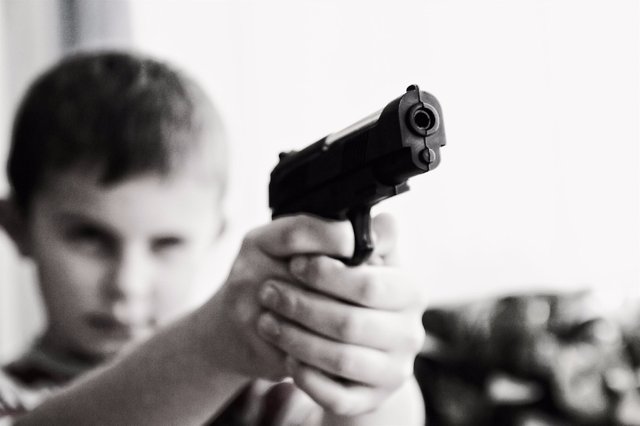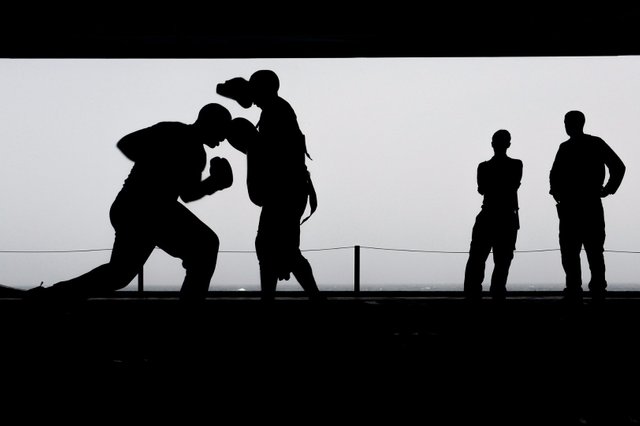Martial Analysis: Mindset

Before the first punch is thrown, the fight is won and lost in the mind.
There are many, many instructors out there discussing a plethora of techniques and drilling down into the finer points of how to properly employ them. There are likewise many teachers who stress timing, footwork and distance. Technique, timing, footwork and distance are important martial skills, but they all rest on the assumption that you are psychologically ready for the fight. If you cannot match your mindset to the moment, no amount of fancy shuffling and technique can save you.
Try this exercise. Go to the middle of the most crowded place in your area, find a target, and ram your fingers into his eyes. No warning, no hesitation, just walk up to him and strike.
Can't do it?
That makes you part of the vast majority of regular people out there. And that is fine. Most humans are hardwired to feel empathy for other humans. This allows people to cooperate and reduce the likelihood of conflicts flaring up into merciless battles to the death. In everyday life, there simply isn't a need to switch off your ability to empathise with someone and go ballistic.
But a fight is not everyday life.
Professional athletes have it easier. They know the date and place of their next match, and sometimes their opponent. They have weeks, months, even years to train. As the day and hour approaches, they can pump themselves up, visualise themselves performing at their best, and mentally prepare for the fight.
Combat is nowhere near like that.
Nobody will warn you that they are going to attack you. Regular people won't have a crystal ball that tells them when they will be attacked. All people can do is read the people and the environment around them. If you're lucky, you get a monkey dance, with the participants working themselves up into throwing the first punch. If you're not, you'll get a blitz.
Being on the receiving end of a blitz is scary. The attack is close and sudden and hard and fast. You'll have little to no time to react to everything coming in. The attacker will overwhelm you with screaming, constant forward pressure, attacks from multiple angles, shutting down your ability to respond. With so much going on, the mind shuts down. Everything does blank. You freeze.
And you die.
The Stranger in the Park
Many years ago, I was returning home from a writers' gathering. It was late at night and I was heading for the train station. I decided to walk through a nearby park. It was well-lit, but the hedges and the plants and trees isolated me from the world. Deeper into the park, I sat down at a bench to take in the world. I looked around.
And saw him.
A tall, dark individual strolling down the path. The only path in and out of the area I was in, so narrow I couldn't create distance. I glanced at him and felt the weight of his gaze on me. I looked down. He was still staring at me.
I stood up. Got out my phone.
Walked towards him.
As I approached I kept him in my peripheral vision, ready to trigger on sudden movements. I moved slowly and casually, but kept a tight grip on my phone. I readied myself to drive it into his throat if I had to. I took deep oxygenating breaths and readied myself.
We approached.
We brushed past each other.
Nothing happened. I left the park and headed for the train station.
Fortunately for everyone involved, nothing happened. But if he had attacked me, I would have been ready.
There was only one exit and no witnesses. When the person appeared, I decided I couldn't leave from the other side. It would place my back to him, and a determined aggressor could run up behind me and strike. I decided I had to face him head-on to give myself a fighting chance.
I readied a tool, reconciled myself to the possibility of combat, and faced the danger zone head on. I had prepared myself for combat, and readied to strike at the first sign of imminent danger. And when I determined that violence was not called for, I calmed myself and left.
That is mindset. The readiness and willingness to respond if necessary, and the ability to step down when it is not.

Developing Mindset
For most of your life, there is a high chance you would have been raised to be a fine, upstanding citizen. Obey the law, follow directions, talk civilly, try to reason with people and so on. These are outstanding traits, but they only apply to regular life. Combat is not regular life. You must be prepared to harm people so quickly and brutally that they cannot do the same to you. It requires seeing them not as human beings but as harmful threats to be ended, like particularly dangerous cattle for the slaughter. If you apply the mindset of a civilised person in the toxic brew of combat, you will die.
The first step to developing a warrior's mindset is to give yourself permission to attack. Reconcile yourself to the possibility that you may one day be robbed, assaulted, raped, stabbed or shot for any number of arbitrary reasons. Run yourself down a list of potential scenarios: a carjacking, a mugging, a home invasion, and ask yourself how you would respond.
Be honest with yourself.
Would you be willing to gouge eyes and rip throats if someone was trying to rob you? What if that person decided taking your stuff wasn't enough, and escalated to rape and murder? What if a drug-addled home invader broke in late at night and went after your children?
What would you fight for? What would you kill for? And, most of all, what would you not fight or kill for?
The answers to these questions tell you what techniques you are willing to apply when under pressure. This is not about what you can physically do, but what you allow yourself to do. You may, for instance, be confronted with a pistol-wielding terrorist about to execute you. Your body may be physically capable of stripping the gun and turning it on him, but if you are so afraid or so unwilling to harm him that you won't do it, techniques are moot.
You must give yourself permission to defend yourself and your loved ones in a critical event. If you do not, your brain will hang up and everybody will be at risk. Most of all, yourself.

The Eyes of a Predator
Armed with these answers, go forth and look at the world around you with the eyes of a predator. Identify blind spots and opportunities to set up ambushes. Look for choke points and kill zones where prey must funnel through. Look for signs that forbid people from defending themselves and see how you can circumvent local defences.
Observe the people around you. Are they fit or flabby? Do they have their heads up and scanning or their heads down and staring at screens? Are they listening to everything around them or are they listening to loud music pumping through their headphones? Who seems capable of defending themselves and who will not be?
This is how a predator looks at the world. This is how they will assess you and the environment. With this information, go one step further. Think about how you can bypass or observe these kill zones. Ask yourself if you really have to pass through danger areas, and if so, how you can minimise your exposure. See how you comport yourself with the eyes of a predator and ask if you are an easy mark. And if so, how you can change your behaviours and posture to be less of one?
Do not be where the danger is. That is the essence of self-defence. But if danger finds you anyway, you need to deal with it.

The Gravest Extreme
When faced with a blitz, it's easy for most people to go, Oh my God I'm gonna die!
They flinch, get their hands up, rear away, and be bowled over. If they are lucky they can flail their arms and get off a few ineffectual 'attacks'. But they are not ready, and they will lose.
When faced with sudden violence, your first response must be, FIGHT!
When training, this is how you should think and act. Respond to aggression with aggression. The goal is to survive and end the threat right now. He does not get a turn, he never gets a turn. You take him down and move on.
There are two ways most martial arts achieve this. The first is to cultivate raw aggression. When the adrenaline hits, you burn it to induce a ferocious rage. You charge the attack and wipe out the attacker before he can respond. This is the hallmark of many hard or 'external' styles, such as Krav Maga or Muay Thai. The second is to become cold and implacable, riding the adrenaline rush to eliminate the threat, utilising the calm to employ more sophisticated techniques and tactics. Many internal martial arts like Tai Chi and Systema use a lot of breathing and relaxation work to achieve this.
The former is like a relentless wildfire, burning down everything in its path. The latter is a black hole, consuming all. In either case, the ideal is to transcend your ordinary human experience and become the avatar of a force of destruction.
Remember that all techniques flow from mindset. If you are not ready to destroy your opponent, but he is willing to destroy you, the only question is whether you are going to the hospital or the morgue.
Now the difficult part: you have to know when to back off.
The law only allows for reasonable force to defend yourself. Gratuitous violence will be punished with criminal charges. And you have to live with what you have done. It is well and good to work yourself up into a all-destroying rage, but you must be able to calm down immediately or face the consequences.

Putting It All Together
Training technique is well and good, but if you are training for combat you must also develop a combative mindset.
Understand your personality and ethics. What would you fight for? What are you willing to do to your enemy under what circumstances? When you fight, are you the kind to become a wildfire or a black hole? When training, focus on techniques, combinations and tactics that suit your mindset best.
When training solo, visualise yourself being attacked out of the blue. Train your mind to go FIGHT! when the scenario begins and unload on the attacker. If you have friends, role-play scenarios as realistically as you can, and go as hard and as fast as possible. Don't throw halfhearted attacks and blocks; do go full power if you safely can. Best of all, get safety gear and bang it out. Be dynamic and noncompliant: the attacker should respond realistically, looking for holes to counter the counterattack. Embody the ferocity you need in a safe environment.
When training, learn to escalate and de-escalate. Be cognizant of what your moves to the threat and the legal consequences thereof. If you've knocked out an adversary, stomping his ankle is illegal. But if he gets up despite the damage and his friends are rushing in, the ankle stomp is necessary. Train for both events. Train yourself to go hard when you must in the face of continued resistance, and to stop when the threat is no longer a threat.
All deeds flow from mindset. The human body can employ a veritable arsenal of techniques. But to use them effectively, you must give yourself permission to defend yourself.
Bonus for Writers
If you are a writer, look at your characters' experiences, background and personalities. Apply the above ideas and concepts to them. What is violence to them? Something outside everyday experience? A possibility they must prepare for? Something they have only experienced in combat? Or part of their job?
The more familiar and intimate they are with violence, the more likely they will have developed a predatory mindset. For violence professionals -- soldiers, cops, hired killers -- it is mandatory when on the job. This mindset manifests in behaviours and actions: an abundance of caution and wariness, constant scanning, walking in circles to detect tails, carrying concealed weapons, body positioning to be ready for violence. Other characters experienced in violence will notice these tails and react accordingly.
What you want to do is to have your characters act and talk in line with their training and lived experience. A combat veteran should not act like a clueless civilian, a professional criminal will find ways to carry weapons on him when necessary, and a sniper would scan windows and high-rises everywhere he goes. If a character's deeds are not consistent with his described expertise, it leads to cognitive dissonance and creates the impression of weak writing.
Any dissonance should be deliberate on your part. For instance, if you have a civilian scanning rooms and people like a pro, it's a sign that he's not what he seems. Similarly, someone reputed to be a heavy hitter may decide to act carelessly to lure his enemies into a trap. Dissonance must be justified to believed.
When in combat, one way to differentiate between characters is the emotions and the mentality they bring to the table. A berserker will charge the enemy in a combat high, disregarding danger. Soldiers and tactical units will work together to overwhelm the enemy. A more calculating sort would analyse the situation and strike accordingly. Understand how a character's experience, training and personality intersect and manifest in their deeds. This allows you to make different characters distinct in a reader's eyes.
Further Reading
I am not speaking ex cathedra and I am no expert. This post is just an overview; it is not a be-all and end-all guide. For more information, please read Rory Miller's Facing Violence and Force Decisions, and Kelly McCann's Combatives for Street Survival.
For another post on mindset, read Dark Triad Man's post here.
To learn how criminals think, see No Nonsense Self Defense here.
Photos from Pixabay and Unsplash.
If you have enjoyed this post, please upvote and resteem it. If you would like more posts about violence, please let me know in the comments. Thanks!